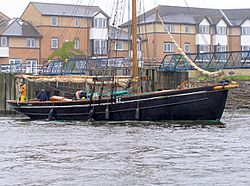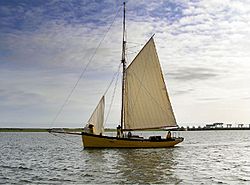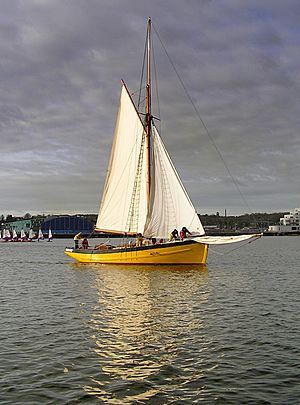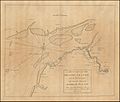Bristol Channel pilot cutter facts for kids
A Bristol Channel pilot cutter was a special type of sailing boat. It was designed to be fast and easy to handle. These boats were used in the Bristol Channel in England. Their main job was to carry expert sailors called maritime pilots. These pilots would guide large ships safely into or out of busy ports.
The Bristol Channel has strong tides and tricky waters. So, these cutters needed to be very speedy and easy to steer. They could get to big ships quickly, even in bad weather. A small crew, often just two people, could manage them. They could also wait for days or weeks for ships to arrive. Many people think their design was one of the best ever for a sailing boat!
Over time, new ships with steam engines and metal hulls appeared. This meant the wooden sailing cutters were no longer needed. Many were sold, and some were lost. Today, only a few of these amazing boats still exist.
Contents
What is a Cutter?
When we talk about sailing boats, a cutter is a type of boat with one mast. It usually has two or more front sails. Cutters often have a long pole sticking out from the front, called a bowsprit. Their mast is usually set further back than on a sloop. Cutters were often used for coastal jobs. This included patrolling, carrying passengers, or moving light cargo.
The Dangerous Bristol Channel

The Bristol Channel is known for being one of the most dangerous shipping areas in the world. It has huge tides, which can rise and fall over 14 meters (46 feet)! This is almost as much as the Bay of Fundy in Canada. The currents can also be very fast, up to 7 knots (8 mph). This is faster than many old sailing ships could go!
These strong tides and currents can hide rocks and constantly move sandbanks. This makes the water very tricky to navigate. Today, there are no bridges or tunnels across the Bristol Channel. People cross by sea, air, or by going around the River Severn estuary.
Because the waters are so dangerous, ships always needed local pilots. These pilots knew the winds, tides, and hidden dangers. As cities like Bristol grew, more ships came and went. This made the pilots' job even more important. Ship owners wanted to protect their valuable ships and cargo.
How They Were Designed

Most fishing boats were heavy and slow. They were built to carry a lot of fish and were stable. But pilots needed something different. Early pilot boats were based on fishing cutters. Over time, they became the special Bristol Channel pilot cutters we know.
These boats are often called the best sailing boats ever built for their type of rigging. Here's why they were so good:
- Speed and Depth: Pilots were in a race against each other and the weather. These boats were fast and could sail in different water depths. This helped them get around in all tides.
- Strong and Safe: They had to race to ships in huge Atlantic Ocean waves, even in winter. They needed to work in all weather and keep the crew safe.
- Easy to Steer: Besides being fast, a pilot cutter had to be easy to control. This allowed them to safely transfer the pilot to a larger ship in any weather. They also had to pick up pilots from ships leaving port.
- Simple to Handle: Fewer crew members meant more profit and an easier work life. Usually, only a man and a boy handled the boat, besides the pilot.
Their Basic Shape
The design of these cutters combined a deep hull, a long keel, and a powerful gaff cutter rig. This made them light but very strong. They had large, steeply angled keels. This allowed them to go deep in the water when sailing fast, but also stay in shallower water with less sail.
Boat builders and owners kept trying new ideas for over 90 years. This constant testing made the boats faster and able to work in all weather. Many people believe this led to the best sailing boat design ever. Admiral John R. Muir once said that no pilot cutter was ever lost due to bad weather in the Bristol Channel, which shows how tough they were.
How They Operated
Cutters would leave their home ports in the Channel, heading towards the open ocean. Sometimes, a shipping company would hire them. More often, pilots worked for themselves and competed with others.
After 1858, cutters had to show white side lights when sailing. But often, on their way out, they would turn these off. This was to get a head start on their rivals! Once they reached their waiting area, which could be for weeks, they had to fly a pilot flag. Since 1849, this has been a white flag over a red one. At night, they had to fire kerosene flares. Each port had its own flare signal. For Bristol, it was two short flashes and one long one.
When a ship was found, the cargo ship would slow down. The cutter would then pull up alongside it. An apprentice would row the pilot in a small boat to the larger vessel. The cutter's captain would then sail away. The cutter would return once the pilot was on board and the ship was moving. If the cutter had two pilots, they would repeat the process for another ship. If not, they would race back home.
Later, when steam power became common, some cutters were towed back to port. This was not popular with either the steamship crews or the cutter crews!
Off-Duty Fun
When they weren't busy guiding ships, cutter captains would take part in "reviews" in the ports. These were like parades combined with open races. In windy conditions, these cutters often beat professional racing boats. With all their sails up, they could reach speeds over 10 knots (11.5 mph)! Ilfracombe was a popular place for an annual review. Its long, flat sands were great for repairs, and it was a good holiday spot for the crews' families.
The End of Sail
In 1913, all the Cardiff pilots joined a new company. This company bought new steam-powered pilot boats. They did not buy the old sailing cutters, which were still owned by their captains. This meant many cutters were sold to become private yachts. The last sailing pilot cutters stopped working in the early 1920s. This was because new steam and diesel boats were faster and more efficient. The Cariad was the very last sail-powered pilot cutter to retire in 1922.
The Story of Mischief

Mischief was a 45-foot (13.7-meter) Bristol Channel pilot cutter. She was built in Cardiff in 1906. Her first pilot was William “Billy the Mischief” Morgan. He once sailed her into Ilfracombe harbour in terrible weather. This showed his amazing skill and earned him and his boat great respect.
In 1921, Mischief was sold. She had several owners and ended up in Valletta, Malta. In 1954, a famous climber and explorer named Bill Tilman bought her. After some repairs, he sailed her over 110,000 miles (177,000 km)! He sailed from the Antarctic to the Arctic, visiting places like Patagonia, Greenland, and South Georgia. Tilman wrote six books about his adventures on Mischief. But in 1968, she hit a rock near Jan Mayen Island in the Arctic Ocean. She began to sink and was then crushed by ice.
Tilman continued his adventures on two other Bristol Channel pilot cutters, Sea Breeze and Baroque. In 1977, when he was 80, he joined a trip to climb Smith Island. Sadly, the ship disappeared with everyone on board while sailing between Rio de Janeiro and the Falkland Islands.
In 2007, a new Mischief was built, just like the original.
Saving These Boats
Today, only 18 original Bristol Channel pilot cutters are thought to still exist. Some can be rented for private trips. Many also attend boat shows and sometimes join the Barry Yacht Club's annual "Cock of the Bristol Channel" race.
| Name | Date | Builder | Original Owner | Length | Beam | Draft | Displacement | Current Location | Notes | Website |
|---|---|---|---|---|---|---|---|---|---|---|
| Alpha | 1904 | William Stober, Fleetwood | William Prosser | 52 feet (16 m) | 14.6 feet (4.5 m) | 8.5 feet (2.6 m) | 36 tonnes (35 long tons; 40 short tons) | Shuna Island, Scotland | Privately owned | [1] |
| Baroque | 1902 | J Hambly, Cardiff | 50.2 feet (15.3 m) | 13.5 feet (4.1 m) | 8.5 feet (2.6 m) | 32 tonnes (31 long tons; 35 short tons) | Stockholm, Sweden | Privately owned | [2] | |
| Breeze | 1887 | J.Cooper, Pill | 38 feet (12 m) | 12 feet (3.7 m) | Somerset | Privately owned | [3] | |||
| Cariad | 1904 | Edwin "Cracker" Rowles, Pill | Thomas Richards, Cardiff | 47 feet (14 m) | 12.75 feet (3.89 m) | 7.5 feet (2.3 m) | 30 tonnes (30 long tons; 33 short tons) | Dartmouth, Devon | Cariad (Welsh for Loved One) was the last working sail-powered pilot cutter by 1922. She was bought by Frank George Griffith Carr as his private yacht. She was saved in 1972 at the Exeter Maritime Museum. After the museum closed, she was sold again. She was relaunched in 2006 after a big repair. She was even featured on the TV show Boats that Built Britain. | [4] |
| Carlotta | 1899 | WH Halford, Gloucester | 50 feet (15 m) | 13 feet (4.0 m) | 8 feet (2.4 m) | 28 tonnes (28 long tons; 31 short tons) | British Columbia, Canada | She was first called The Solway and worked as a fisheries police boat. She was sold in 1907 and has been a private yacht since then. She is privately owned. | [5] | |
| Cornubia | 1911 | J Slade & Sons, Fowey | Morrice, Barry | 52 feet (16 m) | 13.7 feet (4.2 m) | 7.3 feet (2.2 m) | 30 tonnes (30 long tons; 33 short tons) | Plymouth, Devon | After being sold in 1917, she was renamed Hirta. She is famous for being owned by Tom Cunliffe, who sailed her to many places, including Greenland and the United States. Cunliffe sold her, and she was heavily repaired. Now, only 11 of her original wooden parts remain. | [6] |
| Dolphin | 1909 | J.Bowden, Porthleven | 38.8 feet (11.8 m) | 11.5 feet (3.5 m) | 7.5 feet (2.3 m) | 19 tonnes (19 long tons; 21 short tons) | Northern Europe | She is the only surviving cutter with a flat back (transom stern), apart from Breeze. She is privately owned. | [7] | |
| Frolic | 1905 | J.Westmacott, Bideford | Alf Edwards, Cardiff | 55 feet (17 m) | 13.4 feet (4.1 m) | 8.7 feet (2.7 m) | 35 tonnes (34 long tons; 39 short tons) | Norway | She is the only surviving cutter with a flat back (transom stern), apart from Breeze. She is privately owned. | [8] |
| Kindly Light | 1911 | Armour Brothers, Fleetwood | Lewis Alexander, Barry | 53.97 feet (16.45 m) | 14.49 feet (4.42 m) | 8.49 feet (2.59 m) | 20 tonnes (20 long tons; 22 short tons) | Gweek, Cornwall | Lewis Alexander wanted a pilot cutter built by the same foreman who designed the successful ALPHA. She cost more than other cutters. After World War I, she was considered the fastest of the 100 cutters still working. She is now privately saved and is on the list of National Historic Ships. | [9] |
| Letty | 1905 | E.Rowles, Pill | 52.5 feet (16.0 m) | 13.5 feet (4.1 m) | 8.5 feet (2.6 m) | Cornwall | [10] | |||
| Madcap | 1875 | Davies & Plain, Cardiff | 43.2 feet (13.2 m) | 12.3 feet (3.7 m) | 7.5 feet (2.3 m) | 22 tonnes (22 long tons; 24 short tons) | Belfast, Northern Ireland | She was sold in 2014 to a French group and repaired in La Rochelle. | [11] | |
| Marguerite | 1893 | E.Rowles, Pill | Frank Trott | 53 feet (16 m) | 13 feet 10 inches (4.22 m) | 8.3 feet (2.5 m) | 35 tonnes (34 long tons; 39 short tons) | River Fal, Cornwall | She was built for Frank Trott. He had a towing hook added to her front. This was so steam-powered cargo ships could tow Marguerite back to port. | [12] |
| Marian | 1889 | J Hambly, Cardiff | 50 feet (15 m) | 12.9 feet (3.9 m) | 7.8 feet (2.4 m) | 28 tonnes (28 long tons; 31 short tons) | Cornwall | [13] | ||
| Mascotte | 1904 | Thomas Cox, Newport | 60 feet (18 m) | 15 feet (4.6 m) | 9.5 feet (2.9 m) | 44 tonnes (43 long tons; 49 short tons) | Arisaig, Scotland | She is privately owned and is the largest of the surviving boats. | [14] | |
| Olga | 1909 | J.Bowden, Porthleven | 56 feet (17 m) | 13.6 feet (4.1 m) | 8.6 feet (2.6 m) | 32 tonnes (31 long tons; 35 short tons) | Swansea Museum | She is kept at the Swansea Museum. | [15] | |
| Peggy | 1904 | E.Rowles, Pill | Richard Arthur Case | 45 feet (14 m) | 12.5 feet (3.8 m) | 7 feet 6 inches (2.29 m) | 23 tonnes (23 long tons; 25 short tons) | Bristol Harbour | She was first named Wave and had the number 10 on her main sail. She was changed into a yacht in the 1920s and renamed Peggy. Mr. Diccon Pridie has owned her since 1973. She was used as the model for a new replica boat called Polly Agatha. | [16] |
| Raider | 1910 | Kitto, Porthleven | George Bennett, Barry | 48 feet (15 m) | 14 feet (4.3 m) | 8.5 feet (2.6 m) | 30 tonnes (30 long tons; 33 short tons) | Vineyard Haven, Massachusetts | She was named after George Bennett's daughter. She was changed into a yacht in the early 1920s. | [17] |
| Vivacious | 1910 | J.Slade & Sons, Polruan | 48 feet (15 m) | 13.25 feet (4.04 m) | 7.2 feet (2.2 m) | 27 tonnes (27 long tons; 30 short tons) | South of France | [18] |
New Replica Boats
More and more replica boats are being built today. Many of these new boats are used for private trips and charters.
Images for kids



